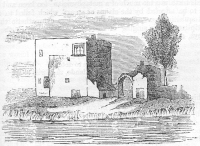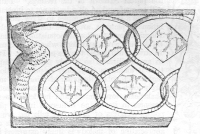Woodstock Castle, County Kildare
From The Illustrated Dublin Journal, Volume 1, Number 26, March 1, 1862
Woodstook,
famed in Irish story,
Raising high its tow'ring head,
Still proclaims its former glory,
Near old Barrow's crystal bed.
O'er
its walls where, ivy creeping,
Loves to wave its sombre green;
Forth, beneath the foliage peeping,
Many a sculptured stone is seen.
Where
the silken standard flying,
Once its waving folds display'd;
Now the breeze, in murmurs sighing,
Mourns the havoc time has made.
 TO have the recollection of the
days that are long gone over stirred up in our minds, and to dwell upon
them with affectionate interest, may appear weak in the eyes of true
philosophy. Yet, to dwell fondly on the history of scenes that are for
ever fled, if it be a weakness, seems to be one of the most pardonable
weaknesses of our nature--a frailty as universal as it is interesting.
It is a sobering reflection which we are naturally affected with, and
by it the best sympathies of our nature are often awakened. When
contemplating the mouldering remains of the edifices of our
forefathers, associations press on the mind, linked as they are with
the present and the past, that often convey instruction of no ordinary
kind. Perhaps the Castle of Woodstock, the subject of our present
notice, may be classed amongst others as affording evidence of the
justness of this remark.
TO have the recollection of the
days that are long gone over stirred up in our minds, and to dwell upon
them with affectionate interest, may appear weak in the eyes of true
philosophy. Yet, to dwell fondly on the history of scenes that are for
ever fled, if it be a weakness, seems to be one of the most pardonable
weaknesses of our nature--a frailty as universal as it is interesting.
It is a sobering reflection which we are naturally affected with, and
by it the best sympathies of our nature are often awakened. When
contemplating the mouldering remains of the edifices of our
forefathers, associations press on the mind, linked as they are with
the present and the past, that often convey instruction of no ordinary
kind. Perhaps the Castle of Woodstock, the subject of our present
notice, may be classed amongst others as affording evidence of the
justness of this remark.
From its vicinity, Woodstock Castle has partaken of nearly all the changes that befel Athy. Standing on the western bank of the river Barrow, it was designed to command the principal ford on this part of the river, in conjunction with White's Castle, situate on the opposite bank, a little lower down--the ford lying between. The time this castle was built is unknown. Tradition assigns it to about the year 1290, and that a descendant of the earl of Pembroke was its first master; whilst some antiquaries, with more reason, seem inclined to attribute the erection of the present structure to Thomas Fitzgerald, lord of Offaly, and afterwards seventh earl of Kildare, who, on marrying Dorothea, the daughter of Anthony O'Moore, of Leix, received in dower the manors of Woodstock and Rheban, in which family it still remains. The plan of the building was originally a regular square tower, joining the south side, and built in uniformity with the front facing the river. The walls are of great thickness, and, considering the attacks they have been exposed to, in good preservation. The mullioned windows were much admired, being very elegantly executed. In viewing the interior from what can be collected from the remains, we are struck with the curious arrangements of ancient architecture. A fine arched gateway, and part of the outer court-wall yet remain. Some years since a stone, of which the following cut is a representation, was discovered in the ruins, and is the only piece of sculpture of interest that has, even in a mutilated state, survived.

The ford which the Castle commanded, and from which Athy derives its name, was called Athelehac, or anciently Athlegar, the ford towards the west; also, Ath-trodan, or the cattle ford. It was here the great battle was fought, in the third century, between the people of Munster and those of Leix, under Laviseagh Cean Mordha.
In 1642, the Marquis of Ormond took Woodstock from the rebels; and subsequently, in 1647, Owen Roe O'Neal surprised it, and put the garrison to the sword; his victory, however, was but of short duration, for Lord Inchiquin compelled him, in a little time after, to surrender it and Athy.
